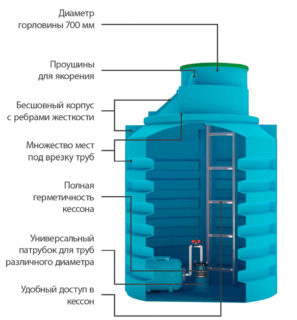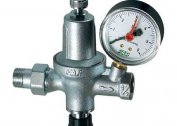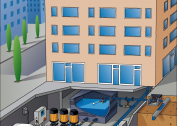To equip the upper part of the well, the masters prefer to mount a caisson. This is a sealed chamber made of various materials - metal, reinforced concrete or polymers. Widespread use of a plastic box Triton. Its technical characteristics fully justify the cost of equipment.
Appointment and scope of triton caissons
Use dense polymer chambers for the proper location of pumping equipment and drainage pipes below the level of freezing of the soil. In addition, such an arrangement of a hydraulic structure reduces the noise level in the area from the working discharge unit.
The main applications of the caisson:
- the device of the upper part of the source and its protection from subzero temperatures, groundwater;
- carrying out in-depth work (the original purpose of the polymer chamber);
- creation of a special tank for storing equipment in the area where construction is not yet completed (here you will have to additionally equip the caisson's hatch with a lock);
- installation of sewer septic tank.
Polymer chambers have the smallest mass, which simplifies their transportation and further installation.
Device and principle of operation
Externally, the caisson is a hollow cylindrical chamber like a barrel. The device has a narrowed neck with a screw-down hatch. It subsequently provides access to equipment and the head of the source. Due to the optimal parameters (width, height, depth) in the Triton box, you can place such equipment for the well:
- filter installations;
- pumping stations, including pressure gauge and storage tank;
- automation to control the operation of equipment.
The parameters of the neck and space of the Triton chamber allow the master, if necessary, to carry out repair, maintenance work in it.
The lineup
 The Triton Plastic company presents several models of caissons on the market. The newest of them is Triton Premium. Has a cross section of 1200 mm. The height of the chamber is 2095 mm. The diameter of the hatch is 800 mm. The mass of the device is 100 kg. The volume of the tank is 1800 liters.
The Triton Plastic company presents several models of caissons on the market. The newest of them is Triton Premium. Has a cross section of 1200 mm. The height of the chamber is 2095 mm. The diameter of the hatch is 800 mm. The mass of the device is 100 kg. The volume of the tank is 1800 liters.
Triton K-Mini
Also a solid model of a camera with a diameter of 960 mm. The weight of the caisson is 85 kg. Height - 2280 mm.
Triton M-1
It has such technical characteristics:
- height - 1500 mm;
- width - 955 mm;
- volume - 1000 liters;
- weight - 65 kg.
It has external stiffeners.
Triton M-2
 It differs in such parameters:
It differs in such parameters:
- weight - 80 kg;
- height - 2095 mm;
- width - 955 mm;
- volume - 1100 liters.
The convenient neck width is 800 mm.
Triton K1
 The camera is characterized by such technical features:
The camera is characterized by such technical features:
- material - cast polymer;
- wall thickness - 14-16 mm;
- width - 1430 mm;
- height (depth) - 2100 mm;
- volume - 1800 l.
The camera weighs 130 kg. Hatch diameter 700 mm.
All models are characterized by a bottom with air pockets. This helps protect the chambers from the negative effects of groundwater and heaving soils.
Features and installation diagram
 The advantage of Triton polymer caissons is that they do not need to be built under a solid concrete base. It is enough to compact the soil and pour a sand cushion. An exception is the high groundwater level on the site. Then a concrete slab needs to be poured under the camera, otherwise the water treatment will simply wash the sandy foundation.
The advantage of Triton polymer caissons is that they do not need to be built under a solid concrete base. It is enough to compact the soil and pour a sand cushion. An exception is the high groundwater level on the site. Then a concrete slab needs to be poured under the camera, otherwise the water treatment will simply wash the sandy foundation.
The sequence of work during the installation of the camera:
- Around the casing, a pit is dug in accordance with the parameters of the caisson. At the same time, the depth and diameter of the pit exceed 20-30 cm.
- The soil at the bottom is carefully compacted and a sand pad 20-30 cm thick is poured.The bulk material is slightly moistened and also tamped. If it is supposed to fill the concrete site, the sand layer should be 7-15 cm. The remaining depth is given for pouring the cement mortar.
- As soon as the base is ready, the caisson is lowered on ropes or ropes, having previously formed a technical hole in its bottom along the section of the casing. It is important to ensure a tight connection between the gap and the pipe. To do this, you can use rubber gaskets, silicone sealant.
- Water pipes are diverted from other technical connectors. It is also important to maintain the tightness of the joints.
- Once the camera is installed, carry out a backfill. To do this, use a mixture of sand and gravel or just sand. Moistened material must be rammed in layers (every 20 cm). In the area of water supply branches, you should act very carefully.
It remains to mount the pumping equipment in the caisson and connect it.
Advantages and disadvantages
 Triton polymer chambers for well construction have the following advantages:
Triton polymer chambers for well construction have the following advantages:
- Full tightness, excluding hit of ground waters in the caisson space.
- Inertness to corrosion, chemical aggressive environments.
- Lack of decay, decomposition over time.
- Low thermal conductivity, which is a good protection of the upper part of the casing from subzero temperatures.
- Long service life.
- The presence of stiffeners on the camera body. They restrain the pressure of heaving soils, protect the caisson from deformation.
Due to the low weight, the camera can be installed on its own without the involvement of special equipment.
Reviews on triton caissons
Judging by the reviews of the Triton Premium caisson and other models, the tanks showed a good side.
Nikita, 31 years old. Last year, a Triton K-2 caisson was put on a sand well on the advice of a friend. Rather, according to his bitter experience. He has had a caisson of reinforced concrete rings for the third year. Leaks constantly, especially in the spring. I set the camera myself with a neighbor. Managed in two days completely. For the second year already, there have been no leaks. How to behave further, let's see.
Misha, 35 years old. With a high level of water supply on the site, I decided to buy and put a polymer box Triton. I really hoped for its excellent tightness. In my area, in the spring, the water costs 80-90 cm. In summer, it leaves up to 2 m. It does not wash out and does not push the caisson out. But apparently technical holes still fail. The primer oozes here. I sin on poorly conducted sealing. But I will not redo it. Outside, he poured cement on the cell. In the summer I just go down, I’ll look at what can be done with hermetic joints, than to strengthen it. The rest of the caisson is not bad. The well did not freeze even at minus 25.
Ilya, 39 years old. To protect the pumping station, Gileks decided to mount a polymer caisson. Chose Triton Superior. Lightweight, large, durable. When installing, welded it to the casing. The filling was carried out with a sand-cement mixture. It is the second year. Everything is dry, tight. Satisfied.



